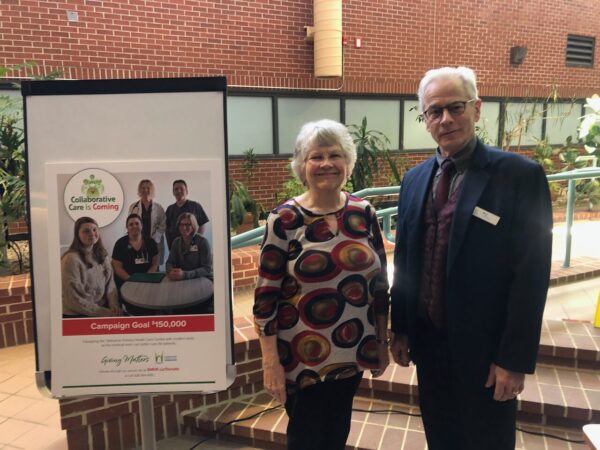
Hear this story on Tantramar Report:
Phyllis Wheaton can remember driving through the Wheaton Covered Bridge with her parents, always honking the horn. It’s a longstanding tradition in New Brunswick’s covered bridges. “Everybody honks the horn going through the bridge, because you can’t see if there’s somebody on the other side,” says Wheaton.
The Wheaton Covered Bridge on High Marsh Road is one of about 56 historic covered bridges left in the province. According to the Tantramar Heritage Trust, the current bridge was built more than a hundred years ago, around 1916. But now its future is in question.
On July 11, the Department of Transportation and Infrastructure (DTI) closed the Wheaton bridge to all traffic, citing public safety concerns. The department says that during a recent annual inspection, DTI workers discovered “significant structural issues” in the bridge, which caused the immediate closure. DTI says that its bridge staff are still conducting further evaluation of the bridge and there is currently no timeline for its reopening.

Phyllis Wheaton and her sister Mary Fawcett not only have nostalgia for the bridge, but they rely on it. Wheaton is one of many farmers who uses the bridge to bring cattle to and from the Tantramar Community Pasture, and Fawcett cuts hay every year on her plot of marsh near the bridge.
“Between my brother and I, we usually do between 600 and 800 bales,” says Fawcett. But this year, the those hay bales will be much more difficult to get home.
The designated detour around the Wheaton Bridge uses the Goose Lake Road all the way up to Midgic, and then loops back on route 940. That adds about 14 kilometers, half of which is a pretty rough ride, says Mary Fawcett. “The Goose Lake Road is not good,” says Fawcett. “Especially the last couple of years, there’s big puddles of water and you don’t know where the bottom is.”
Wheaton echoes the concern. “Who wants to take their animals over a rough road?” she says.
A smoother but much longer alternative is to head across the marsh toward Point de Bute, and then back to Sackville via the Trans Canada highway. That’s also not an attractive option for a farmer hauling haybales or animals, says Fawcett, mostly because it’s much longer. “And if you’re slow moving machinery along side of the Trans Canada Highway,” says Fawcett, “that’s going to be… not good.”
MLA Megan Mitton says she’s heard from constituents who are concerned about the outcome of the closure. “This is really important to the culture and history of our community, but also, it is a transportation route. It’s important for farmers and lots of folks who travel around that area,” says Mitton.
The Memramcook-Tantramar MLA says she’s been passing along concerns to DTI. “I emphasized the importance of getting this open again,” says Mitton, “and to maintain the covered bridge, in addition to just being a route people can drive on.”
Mary Fawcett recalls meeting DTI workers at the bridge four to five years ago, and being told then that the bridge needed some work. Mitton recalls that the bridge has seen reduced weight restrictions, but like so many bridges in the province, no physical reinforcement.
DTI spokesperson Jason MacDonald says that “no immediate repairs were specifically identified for the Wheaton Covered Bridge prior to its most recent inspection.” He also says that vehicles heavier than the posted limit crossing the bridge “would have contributed to the decision to close.”
The bridge does appear to have been struck by a large vehicle trying to enter, but MacDonald says “it is very unlikely those impacts contributed to the bridge closure.”
Mitton remains concerned that DTI is behind on bridge maintenance throughout the province. The department’s annual report for 2022-2023 shows a significant drop in the percentage of bridges considered in ‘good or fair condition’ by DTI’s own assessors.

“What happens is instead of it being done in a planned way, where it doesn’t need to close,” says Mitton, “we see that things wash out or get closed.”
Mitton points to the situation on route 106 between Sackville and Dorchester, which was closed for about two months after a culvert collapsed before it was slated for replacement. “This is unfortunately the reality of New Brunswick, because of not maintaining our infrastructure,” says Mitton.
Mary Fawcett says that despite annual inspections, she hasn’t seen any real maintenance on the hundred year old structure.
But unfortunately, says Fawcett, DTI “put things off and don’t do anything until things are really broken.”
Phyllis Wheaton is hoping to see the bridge fixed before it’s time for her, and many other farmers, to bring their cattle home from the Tantramar Community Pasture where they spend the summer. She’s also hoping that the Wheaton Covered Bridge will remain just that, a covered bridge.
“I can’t see them tearing it down,” says Wheaton. “I’m hoping that it’s going to get fixed. If they needed another bridge for the bigger machinery, build something beside it… Let the cars and the small vehicles still go through. That’s my hope.”



















